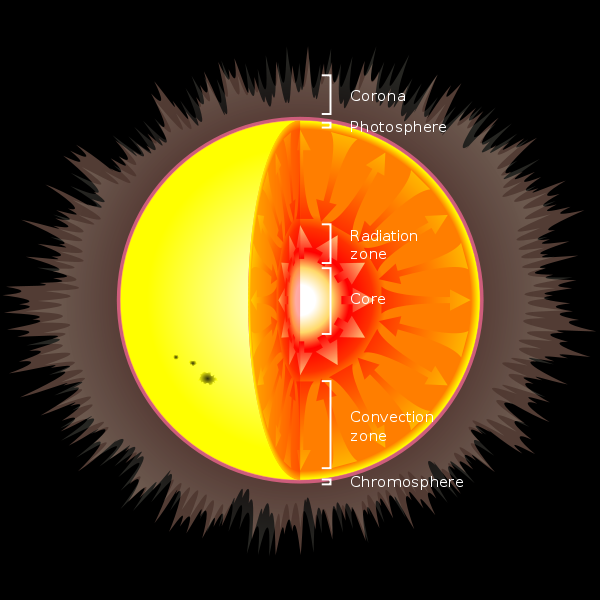13.2: The Solar Atmosphere
( \newcommand{\kernel}{\mathrm{null}\,}\)
 The surface of the Sun exhibits constant activity.
The surface of the Sun exhibits constant activity.
The Sun lacks a solid surface, but if it can be said to have a surface of any kind, it would be the photosphere, the visible, granulated region that sits on top of the convection zone. The photosphere is about 500 km thick and has a temperature about 6000 K. It is the light from the photosphere that we detect on Earth as visible light. Sunspots also occur on the photosphere.
 The various layers of the Sun
The various layers of the Sun
From the top of the photosphere, at about 1500 km thick and a temperature of about 5000 K in temperature is the chromosphere. Slightly cooler than the photosphere, the chromosphere is only visible during a total solar eclipse when the Moon blocks all the light from the photosphere. Spectral analysis can tell us what elements are present in the chromosphere and photosphere. Because the radiation from the solar interior is absorbed and then re-emitted by the photosphere, we cannot use spectral analysis to analyze the Sun’s interior.
 The chromosphere can only be seen from Earth during a total solar eclipse.
The chromosphere can only be seen from Earth during a total solar eclipse.
https:/commons.wikimedia.org/wiki/File:Solar_eclips_1999_5.jpg;
The outermost layer of the solar atmosphere is the corona. With a temperature of about 1 million K, the corona is significantly hotter than the chromosphere, indicating that it must have a source of heat other than energy released from the lower regions. This heat source is probably from electromagnetic interactions of its atoms. Like the chromosphere, the corona is not visible from Earth except during a total solar eclipse where the Moon covers both the photosphere and the chromosphere. The corona appears bright in X-ray photos in places where magnetic fields trap hot gas.
 The corona can only be seen during a total solar eclipse that covers both the photosphere and the chromosphere.
The corona can only be seen during a total solar eclipse that covers both the photosphere and the chromosphere.
https:/commons.wikimedia.org/wiki/File:Solarcorona.jpg;


